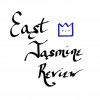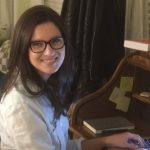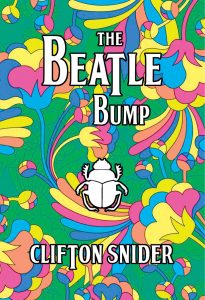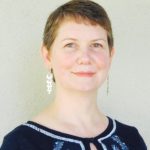Interview: Siobhan Hebron for Post-Trama (Art Exhibit)

Interview with Siobhan Hebron for Post-Trauma, Art Exhibit for Keck Medicine
by Julianne Carew, Fiction Editor
I first heard Siobhan Hebron read her work at a compilation reading of artists with chronic illness. The reading was as eclectic as it was moving, but what I immediately noticed about Siobhan was her in-your-face attitude about illness and the language that surrounds it.
Her short essay, “Hair,” was not about the devastation of losing what most women consider their crowning glory, but instead, about the many other aspects that make living with a chronic illness a reality. Aspects like uncertainty, and the resiliency of the human spirit in the face of it, and the way even devastating news can be turned into art.
At twenty-seven, clad with black leather boots, and a fashion sense that could only be described as effortless, Siobhan Hebron is not your typical cancer patient. She’s a modern-day Gloria Steinem of illness whose mission is to shed new light on the subject, and revolutionize the way we discuss chronic disease.
I sat down to speak with her at the USC Keck Center, where her latest show, Post-Trauma, is currently being exhibited.
Can you tell me a little bit about your diagnosis?
I went to the urgent care and I told them that I had been in excruciating pain for four days. The first urgent care didn’t take me seriously. They gave me a prescription for Norco, and told me to come back in twenty-four hours if I wasn’t feeling better.
I decided that wasn’t going to do it, so I went to another urgent care, and they agreed with me that something was wrong. They told me I could have a blood clot, or a brain tumor, but it was very unlikely. They decided to look into it and perform an MRI.
What do you think the difference was between the first urgent care, that didn’t take you seriously, and the second one, that did?
It’s going to sound really funny, but the first urgent care was a male doctor and the second one was a female doctor. The second one was also, specifically, a head and neck urgent care. I went to them and told them, you know, look, this is what they did for me yesterday and I’m not better. I need help. I’m in too much pain. But that was my first set of concrete circumstances of male versus female pain and treatment management. I think a lot of times, doctor’s prejudices are subliminal. They don’t realize that they treat a man or a woman differently. It’s not because they want to be mean. It’s an unconscious thing.
Once you were diagnosed with a cancerous brain tumor, what happened next?
The doctor’s wanted me to do chemotherapy. But when I was trying to decide what kind of treatment plan to go with, they were also saying that I needed to decide, being a young adult, whether fertility was an issue for me. They told me that in the next couple of days I needed to decide if I’d like to freeze my eggs, and if I did, they’d need to start on that right now.
What did you decide?
I did not do it, for several reasons. Children have never been something that I wanted, neither before, during, or after cancer. But what I took real issue with was the fact that they were essentially saying, “You need to make this decision right now, so that we can move forward.”
At the time, I was thinking to myself, okay, first of all, I’m trying to make one major decision right now, which is whether to pursue treatment for cancer. You can’t ask me to make another giant life decision on top of that. Also, this is a much different decision than if I were a man. If I were a man, this would be an inexpensive, non-invasive treatment. As a woman, it’s extremely expensive, it’s invasive, it’s potentially dangerous. It was that implicit bias that they didn’t take into account for me as the patient.
As a patient, and as someone who has been heavily involved in the healthcare system, what do you recommend could be done to bring awareness to medical misogyny, especially since you mentioned it is mostly subliminal?
I think visibility is critical. When we’re still not in a place to where people are comfortable with talking about illness in an everyday conversation, the burden is on the sick person to educate the healthy people. I think that’s why I’m so cognizant of, and so specific in my language about it, and why I make art, and why I write about it, and why I think it’s so important to be open, and have a really open dialogue about things like that.
What does the word cancer mean to you?
Is it really crazy if I say it means life? I mean, it is my life now. I just went to a wedding this weekend, and I met a whole bunch of new people, and everyone’s asking you, oh, what do you do? What do you do? What do you do? And that’s such a hard conversation for me to have. Right now, I do cancer. That’s what I do. This was especially true a year, or two years ago, when I was smack dab in the middle of treatment. And even though I’m not actively in it right now, it is still so present in my life, in every way, shape, or form.
How did being diagnosed with cancer effect your life?
It threw everything up in the air. Before, I went to UCLA. I double majored in art and art history. I graduated in four years. I did the whole thing, and I was fully on track to pursue art history, not art. I was not going to pursue a studio practice, at all. So I was looking into graduate programs for art history. I was looking to go the Ph.D. route. I didn’t know fully what I was going to do, but that’s what I was looking at. I knew I was going to take at least two years off in between, just after talking with professors and everyone, so that’s kind of where I was. I was in those years off, when this just came out of nowhere.
It really did stop everything. It didn’t change anything biologically or physiologically about me, that would make it impossible for me to still pursue that. I still absolutely could get my Ph.D., but it transformed everything so utterly and completely, and pretty immediately I decided, no, I’m not doing that. I don’t want to do that anymore.
How did the uncertainty of cancer effect your art?
I think the uncertainty, in the beginning, affected the medium the most. In the beginning, right after I was diagnosed, I started making stuff mainly in video and performance. When I was in school, I stayed away from that at all costs. Before my diagnosis my art was very object-based, painting, sculpting, drawing. I wanted to make things.
Once I was creating stuff based on my diagnosis, and thinking about my body and a lot more about this uncertainty and where I was, I didn’t want to make anything so permanent. I didn’t want to make anything that someone could hold in his or her hands, or that could be put on a wall. My art became something that had to be experienced in real time and space. For someone to be a witness to my art they had to be there at that time, in that place, and witness what my body was doing.
Were you insured at the time of your diagnosis?
Yes. When I was diagnosed I was twenty-four, and this was in 2014, right after Obamacare was originally passed. So under Obamacare I was still insured under my parents. And knowing me, having never have been sick, if Obamacare had not been passed, I would have thought, ugh, I’m too young. I don’t need insurance right now. I probably just wouldn’t have done it. So it really, truly, saved my life
What do you have to say about what’s going on in healthcare now?
It’s appalling, and terrifying, and will murder millions of people. It’s inhumane. On election night, healthcare’s the only thing I thought about. I kept thinking to myself, “I’m dead.”
Who do you think will be most effected?
I think the poor will be effected. I think all minorities will be affected. The disabled will be effected, the chronically ill will be effected. The elderly will be effected. Pretty much everyone who is not a rich, white, healthy straight male will be affected. Pretty much everyone who is not the spitting image of a congressman will be affected.
What do you think we should do from here? As an artist, and a patient, and someone who this effects directly, what would you like to see to make people aware?
The calls, the emails, the protests, the things like that. Making art is my outlet for it. But I think anyone who is dealing with issues like this, if they’re comfortable with it, and if they’re in a safe place to do so, I think it is really important to be visible.
It’s so misunderstood, what it takes to live with an illness on a daily basis, and to make that visible to others. Obviously, if you don’t live with it everyday, you’ll never understand it fully. But if you can make people see deeper into that situation, and have more empathy for it, it can only be better for everyone.
People only believe you can either be alive and well, or sick and dying. But people have a real issue with being alive and sick. I think the more people talk about it, and are visible, and see people being alive and sick, and see that we are viable human beings, the more beneficial it will be. Yeah, we’re alive, and we’re sick, and we’re going to continue to be alive if you’ll let us.
Do you think there’s anything the government can do to redeem itself with regards to healthcare? What would you like to see happen?
In a perfect world they could get rid of the American Healthcare Act, and work towards bettering the current system. Because it is working, it is good. It’s not perfect, but, it is the most effective healthcare system this country has ever had. Instead of tearing it down and starting from scratch, let’s start from where we’re at. It’s not perfect, but it’s good. So let’s focus on making it better.
Where does your health stand now?
My health is currently stable. The tumor continues to be stable. I am doing MRIs every twelve weeks. I go in for the scans and then I meet with my neuro-oncologist right after, and he goes over it. It’s so funny that I’m a visual artist and the only way to monitor my tumor is through visual means.
Artistically, what do you see yourself working on in the future?
I still have a great desire to do some kind of durational performance, potentially, over years, where it’s some kind of using up of the body, over time. Truly, my body feels like an art object now because of what’s happened to it, and it also somehow feels like so much has been done to it. Oddly, I feel closer to it, and somehow, more distant from it. It feels almost like it did in the beginning, like my body is some potential object to be used up for art.
____________
Siobhan Hebron
@shebron
siobhanhebron.com
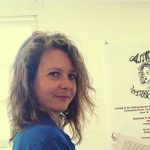 She graduated from UCLA in 2012 with a B.A. in both Art and Art History. Her work engages in feminist social practice, directly embracing community and collaboration, and functions within the idea that a radically honest dialogue is needed to change the socio-cultural perception of health and illness.
She graduated from UCLA in 2012 with a B.A. in both Art and Art History. Her work engages in feminist social practice, directly embracing community and collaboration, and functions within the idea that a radically honest dialogue is needed to change the socio-cultural perception of health and illness.
____________
Julianne Carew
Fiction Editor, East Jasmine Review
Julianne writes new adult and literary fiction. She is currently trying to find a home for her first novel, Why Paintings Fall. She lives in the Los Angeles area, but travels all over the world collecting stories. Her work is featured or forthcoming in The East Jasmine Review, Literally Stories, 805 Literary Magazine, Bewildering Stories, and in numerous anthologies.
